Operation of police powers under the Terrorism Act 2000 and subsequent legislation: Arrests, outcomes, and stop and search Great Britain, year ending September 2020
Updated 6 January 2021
Frequency of release: Quarterly
Forthcoming release: Home Office statistics release calendar
Home Office responsible statistician: John Flatley
Press enquiries: pressoffice@homeoffice.gov.uk, telephone 020 7035 3535
Public enquiries: crimeandpolicestats@homeoffice.gov.uk
Key results
There were 215 arrests for terrorism-related activity in the year ending 30 September 2020, 48 fewer than the number in the previous 12-month period (a fall of 18%). This is mainly due to a reduction in arrests under non-terrorism legislation between April and September 2020.
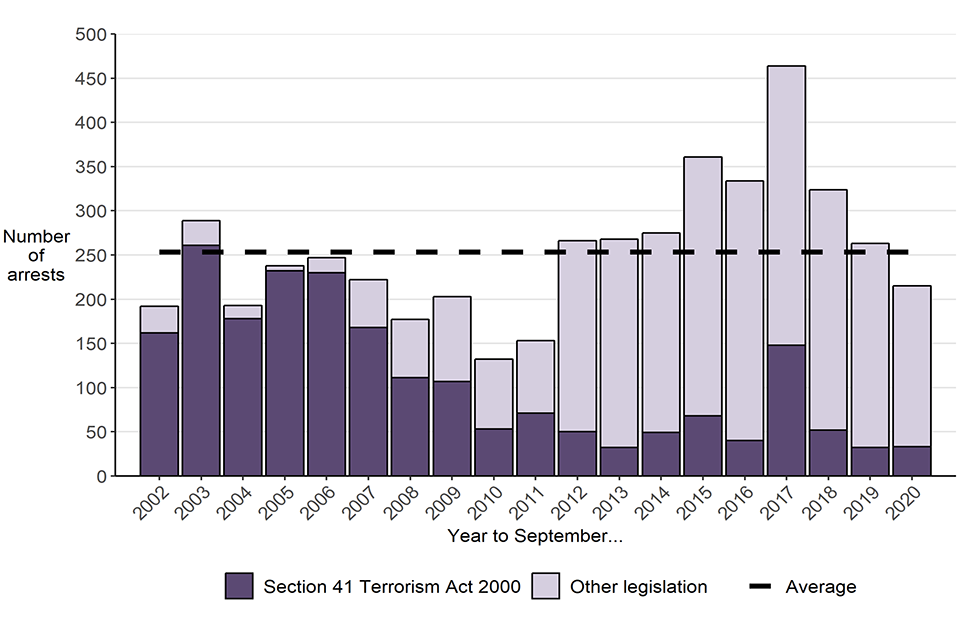
Graph showing number of arrests by year and legislation. The total number of arrests initially fell in the late 2000’s, reaching a low in 2010. They then increased until 2017. Since 2017, arrests have fallen again, and in 2020 are now below the average for the entire time series.
Of the 215 arrests for terrorist-related activity:
- 62 (29%) resulted in a charge, of which 55 were forterrorism-related offences
- 84 (39%) persons were released pending further investigation
- 41 people (19%) were released without charge
- 20 (9%) faced alternative action, for examplereceiving a caution or recalled to prison
- 8 (4%) cases were awaiting an outcome to beassigned
1. Introduction
1.1 Time period covered and data sources
This release covers the use of police powers under terrorism and subsequent legislation in Great Britain on a quarterly basis up to the year ending 30 September 2020. It also covers arrests for terrorist-related activity under other legislation such as the Police and Criminal Evidence Act (PACE).
The statistics in this release draw on a range of data sources. The Arrests and outcomes section contains data provided by the National Counter Terrorism Police Operations Centre (NCTPOC) and includes statistics for Great Britain on the:
- number of arrests for terrorist-related activity and outcomes (such as charges and convictions) following such arrests
- number of charges and convictions broken down by legislation used
- gender, age, ethnicity and nationality of those arrested, charged and convicted
The Court proceedings section uses data from the Crown Prosecution Service Counter Terrorism Division (CPS CTD) and includes statistics for England and Wales on the:
- number of persons proceeded against by CPS CTD for terrorism-related offences
- number of persons that have been prosecuted and convicted broken down by the legislation used
- sentence length of those convicted for terrorism-related offences
The Terrorist prisoners section uses data from HM Prison and Probation Service (HMPPS) and the Scottish Prison Service (SPS) and includes statistics for Great Britain on the number of persons released from custody by sentence length. Data on the ideology, ethnicity, nationality and religion of persons in custody have not been included in this publication as ongoing changes are being made to the way terrorist prisoners are classified. As we are unable to currently publish data on a consistent basis, we have suspended publication of this data while we work with data suppliers to produce revised figures. We anticipate resumption of the release of this data in the next edition of this publication.
The Other police powers under TACT 2000 section uses data provided by the Metropolitan Police Service (MPS) and the National Counter Terrorism Policing Headquarters (NCTPHQ), and includes statistics on the:
- number of stops and searches carried out by MPS under s.43 of TACT 2000
- number of stops and searches carried out by police under s.47a of TACT 2000
- number of examinations and subsequent detentions made in Great Britain under Schedule 7 to TACT 2000
- data on goods examinations, strip searches and on refusals of requests to postpone questioning (usually to enable an individual to consult a solicitor) under Schedule 7 to TACT 2000
From the year ending June 2019 publication onwards, data have also been collected and published on the total number of examinations and detentions made in the United Kingdom as a whole under Schedule 7 to TACT 2000, as well as how many examinations related to intra-UK journeys. An intra-UK examination is when a person has been examined under Schedule 7 TACT at a UK port either before or after a journey between one UK port and another UK port. This includes journeys between or within England, Wales, Northern Ireland and Scotland.
Furthermore, data have also been provided on how frequently other powers have been used in Great Britain under Schedule 7, to restrict or qualify a person’s access to a solicitor. Including: required to consult a solicitor by phone, delayed access to a solicitor, and required to consult in sight and hearing of a qualified officer.
The user guide provides further details on this release, including the strengths and limitations of the datasets, and the quality assurance processes involved in the production of this release. It also includes a summary of the criminal justice process, a glossary of terms used, and detail about the legislation and categories referred to in this release.
A flow chart summarising the Arrests and outcomes section of this release can be found in Annex A.
1.2 Future releases
The information published in the quarterly ‘Operation of police powers under the Terrorism Act 2000’ statistics is kept under review, taking into account the needs of users, and burdens on suppliers and producers, in line with the Code of Practice for Statistics If you have any comments, suggestions or enquiries, please contact the team via email using: crimeandpolicestats@homeoffice.gov.uk.
1.3 National Statistics status
This publication has been assessed by the United Kingdom Statistics Authority and its National Statistics designation was confirmed in May 2016. This means that these statistics meet the highest standards of trustworthiness, impartiality, quality and public value, and are fully compliant with the Code of Practice for Statistics. As part of the assessment process, the Home Office reviewed and improved the user guide that accompanies this release. This now contains more details about the strengths and limitations of the various datasets within the publication, as well as the steps taken to engage with users. Further details on the assessment process can be found on the UK Statistics Authority website.
2. Arrests and outcomes
Key results
- in the year ending 30 September 2020, there were 215 arrests for terrorist-related activity in Great Britain, 48 fewer than the number in the previous 12-month period (a fall of 18%); this is largely due to a reduction in arrests under non-terrorism legislation between April and September 2020, which may reflect the general reduction in crime during this period
- 62 arrests resulted in a charge (29%), of which 55 were for terrorism-related offences
This section presents statistics on the number of persons arrested by the police in Great Britain where there was suspicion of involvement in terrorist-related activity, either at the time of arrest or at a subsequent point in the investigation. In some cases, evidence may emerge after an arrest for a terrorism-related offence that suggests a suspect does not have links to terrorist activity but has committed a non-terrorism-related offence. These cases are included in the data as non-terrorism-related charges and or convictions.
Prior to the June 2018 publication (covering the period to 31 March 2018), data in this release was restricted to arrests where the offence was considered to be related to terrorism. In response to feedback from stakeholders, Home Office statisticians widened the scope of the data collection to include all arrests with a terrorist element whether the offence was terrorism-related or not. This better reflects policing activity in recent years. Data in this release now contain information on all arrests related to terrorism activity, including a full back series.
Since the December 2019 publication (covering the period to 30 September 2019), postal charge requisitions and summonses have been included as part of the figures on arrests. This decision was taken following engagement with NCTPHQ, as the postal charge requisitions and summonses can lead to terrorism-related charges and convictions. See the user guide for more detail.
Outcomes following arrests for terrorist-related activity are also included in the statistics, which show the number of arrests that led to a charge or prosecution as well as other outcomes. Demographic information about those arrested, charged and convicted is also provided in this section. All data in this section are based on the date of arrest. This allows users to see the outcomes of all the arrests in a specific period (such as how many led to a charge and conviction).
As cases progress over time, figures published in this release are likely to be revised. This is particularly relevant for more recent time periods where a larger number of cases will have not been finalised (‘released on bail’ or ‘awaiting prosecution’). The effect on the arrests total will be minimal but the number of charges and convictions currently reported will increase in future releases, especially for cases from the more recent quarters where a greater number have not yet reached the point of charge or conviction.
Data are provided to the Home Office by the National Counter Terrorism Police Operations Centre (NCTPOC) and are taken from a live database. This section includes annual breakdowns of the data from the 11 September 2001 (when the data collection began) to year ending September 2020, as well as quarterly trends over the most recent 9 quarters. The data were based on the latest position of each case as at the time of provision to the Home Office (on 26 October 2020).
A flow chart summarising this section is included in Annex A. This follows individuals from the point of arrest through to charge (or other outcome) and prosecution. Data tables A.01 to A.13 include data on arrests and outcomes. Annual tables, which breakdown the data by rolling years to September, are also provided alongside this release.
2.1 Arrests
In the year ending 30 September 2020, there were 215 arrests for terrorist-related activity in Great Britain, 48 fewer than the previous 12-month period (a fall of 18%). This was the lowest number of arrests for terrorist-related activity in the last nine years to September and is below the annual average of 253 arrests over the entire time series (Figure 2.1).
Figure 2.1: Arrests for terrorist-related activity, by legislation, years ending 30 September 2002 to 30 September 2020, Great Britain1,2,3
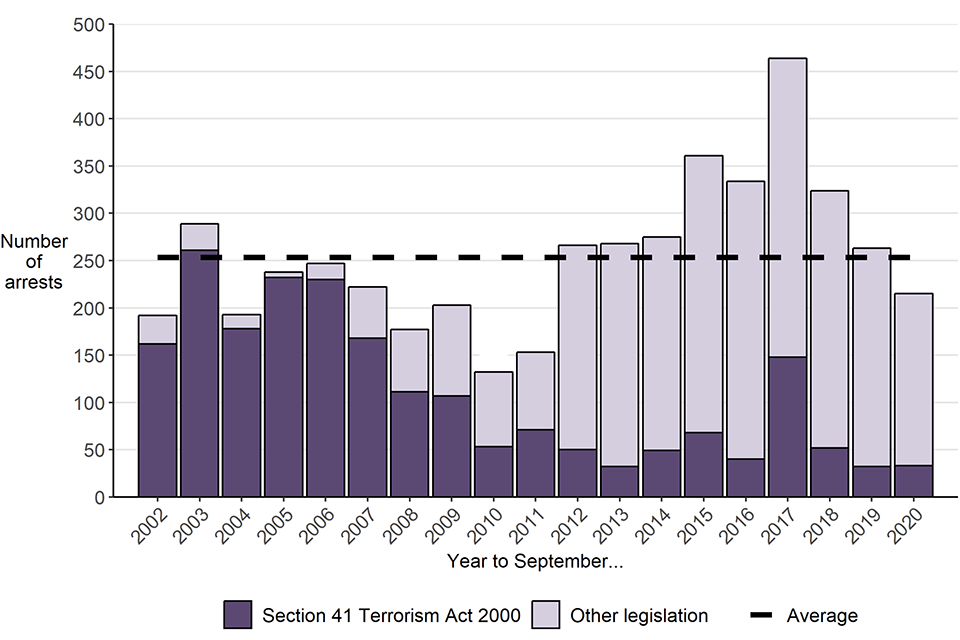
Source: NCTPOC (see data table A.01)
Notes:
- Figures for the year ending 30 September 2002 include data from 11 September 2001 onwards.
- ‘Other legislation’ includes arrests under non-terrorism legislation, such as the Police and Criminal Evidence Act 1984.
- Includes arrests that are considered by the NCTPOC to be terrorism-related, either at the time of arrest or at a subsequent point in the investigation.
Graph showing number of arrests by year and legislation. The total number of arrests initially fell in the late 2000’s, reaching a low in 2010. They then increased until 2017. Since 2017, arrests have fallen again, and in 2020 are now below the average for the entire time series.
Within the latest 12-month period, there was considerable variation in levels of arrests by quarter (Figure 2.2). In both the last two quarters, the number of arrests were below the average number of arrests in the last 9 quarters (61). There were 44 arrests made in the three-month period between July and September 2020 and 31 arrests between April 2020 and June 2020. This six-month period was the main driver for the year ending September 2020 having the lowest number of terrorism-related arrests in the last nine years. These reductions were most evident in arrests under non-terrorism legislation and may reflect the general reduction in crime during this period when there were restrictions on normal activities to control the spread of the COVID-19 virus[footnote 1].
Figure 2.2: Arrests for terrorist-related activity, by legislation, 9 quarters to 30 September 2020, Great Britain1,2
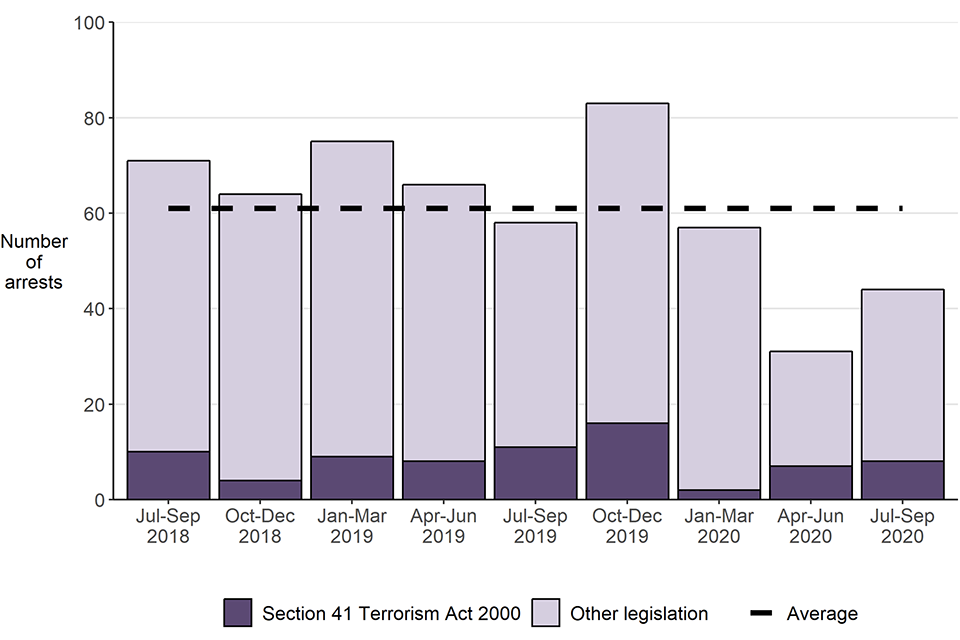
Source: NCTPOC (see data table Q.01)
Notes:
- ‘Other legislation’ includes arrests under non-terrorism legislation, such as the Police and Criminal Evidence Act 1984.
- Includes arrests that are considered by the NCTPOC to be terrorism-related, either at the time of arrest or at a subsequent point in the investigation.
Graph showing number of arrests, by legislation, for the 9 quarters to September 2020. April to June 2020 and July to September 2020 saw the lowest and second lowest number of arrests in the last 9 quarters.
2.2 Pre-charge detention under Section 41 of the Terrorism Act 2000
Once a suspect has been arrested by the police, they may be held for a specified period of time before being charged, giving the police time to investigate and gather evidence related to potential terrorism offences. The current maximum period of detention under s.41 of TACT 2000 is 14 days (which reduced from the previous limit of 28 days on 25 January 2011). This compares with a maximum of 4 days under standard arrest powers. Further details of the legislation can be found in the user guide.
There were 33 detentions under s.41 of TACT 2000 in the year ending 30 September 2020, a similar figure to the previous year, in which there were 32 detentions. Of the 33 detentions in the latest year, 17 led to a charge (52%).
Further details on the length and outcomes of detentions under s.41 of TACT 2000 can be found in data table A.02.
2.3 Charges
In line with the general convention for Home Office criminal justice statistics, when a person is charged or prosecuted for multiple offences at the same time, only the most serious offence is counted – usually the one that carries the highest penalty. This “principal offence rule” means the statistics provide a count of individuals charged rather than the total number of charges. More detailed information on the principal offence rule can be found in the accompanying user guide. Further details of the legislation under which persons have been charged following an arrest for a terrorism-related activity can be found in data tables A.05a-c.
Of the 215 arrests for terrorist-related activity in the year ending 30 September 2020:
- 62 (29%) resulted in a charge, of which 55 were charged with terrorism-related offences
- 84 (39%) persons were either released under bail pending further investigation or released under investigation without bail conditions
- 41 people (19%) were released without charge
- 20 (9%) faced alternative action, for example receiving a caution, being recalled to prison or being transferred to immigration authorities
- 8 cases (4%) were awaiting an outcome to be assigned at the time of analysis.
Given the number of cases still to be finalised in the latest year, the current charge rate shown in the more recent years/quarters is likely to be lower than final figures which will be published in subsequent releases. Until all cases in a given period are finalised, care should be taken when comparing charge rates over time.
Figure 2.3: Charging outcomes following an arrest for terrorist-related activity, 9 quarters to 30 September 2020, Great Britain1,2
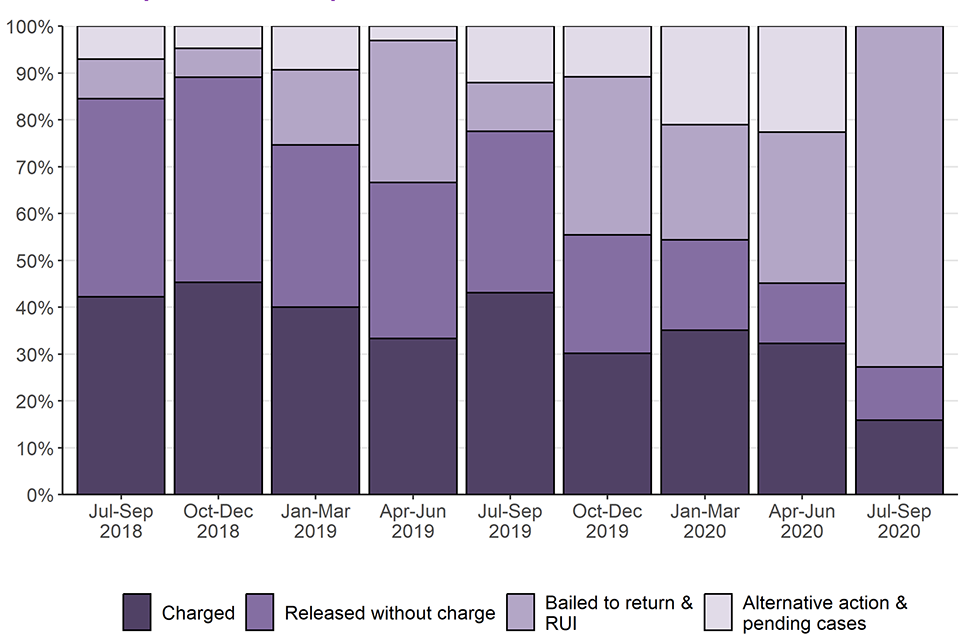
Source: NCTPOC (see data table A.03)
Notes:
- ‘Alternative action’ includes cautions for non-TACT 2000 offences, detentions under the Mental Health Act, recall to prison etc.
- ‘Bailed to return’ includes those released on bail pending further investigation, and those who have absconded from bail. Those who were released under investigation were previously unable to be recorded separately and were recorded as ‘released without charge’.
Graph showing charging outcomes following an arrest, by proportion, for the 9 quarters to 30 September 2020. Of the 215 arrests in the latest quarter, 29% have been charged, 39% are on bail or under investigation without bail conditions, 19% were released without charge, 9% faced alternative action and 4% were awaiting an outcome to be assigned. The charge rate is likely to increase as more cases are finalised.
Figure 2.4: Charging outcomes following an arrest for terrorist-related activity, year ending September 2002 to September 2020, Great Britain1,2
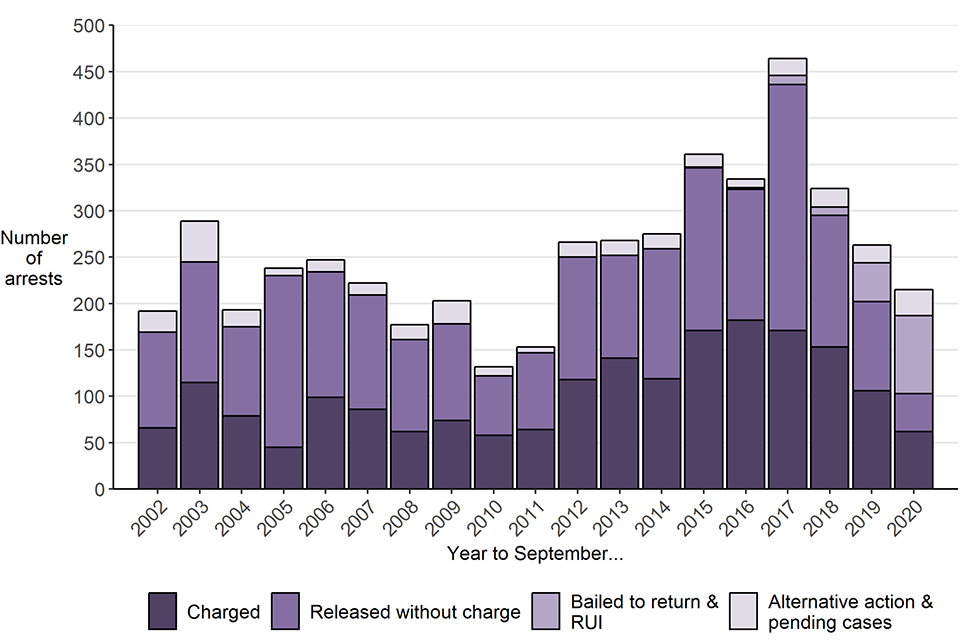
Source: NCTPOC (see data table A.03)
Notes:
- ‘Alternative action’ includes cautions for non-TACT offences, detentions under the Mental Health Act, recall to prison, and transfers to immigration authorities.
- ‘Bailed to return’ includes those released on bail pending further investigations, and those who have absconded from bail. Those who were released under investigation were previously unable to be recorded separately and were recorded as ‘released without charge’.
Graph showing by number of arrests, by charging outcome, for the years ending September 2002 to September 2020. Of the 215 arrests for terrorist-related activity in the year ending 30 September 2020: 62 resulted in a charge. 84 persons were either released under bail pending further investigation or released under investigation without bail conditions. 41 people were released without charge. 28 faced alternative action or were awaiting an outcome to be assigned at the time of analysis.
2.4 Prosecutions
As with charges, statistics on prosecutions are also based on the principal offence rule (see section 2.3). Where an individual is prosecuted for more than one offence at a time, they are classified in terms of a single offence – usually the most serious.
Figure 2.5 shows the outcomes following a charge for a terrorism-related offence.
Further details of the specific legislation under which persons have been convicted following a charge for a terrorism-related offence can be found in data tables A.08a-c.
Figure 2.5: Outcomes following a charge for a terrorism-related offence, year ending 30 September 20201,2,3,4, Great Britain
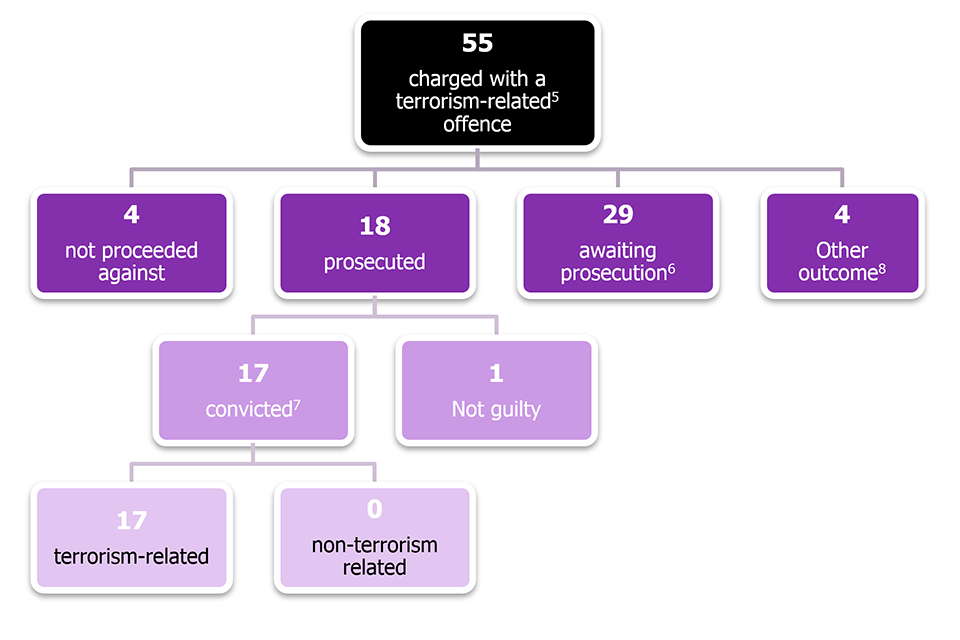
Source: NCTPOC (see data table A.06c)
Notes:
- Based on the time of arrest.
- A more detailed flow chart can be found in Annex A.
- Data presented are based on the latest position with each case as at the date of data provision from NCTPOC (26 October 2020).
- The chart does not include outcomes following non-terrorism-related charges.
- Terrorism-related charges and convictions include some charges and convictions under non-terrorism legislation, where the offence is considered to be terrorism-related.
- Cases that are ‘awaiting prosecution’ are not yet complete. As time passes, these cases will eventually lead to a prosecution, ‘other’ outcome, or it may be decided that the individual will not be proceeded against.
- Excludes convictions that were later quashed on appeal.
- Includes other cases/outcomes such as cautions, transfers to UK Border Agencies, the offender being circulated as wanted and extraditions.
Flow chart showing outcomes following a charge of a terrorism-related offence. In the year ending 30 September 2020, there were 55 people charged with a terrorism-related offence. Of these, 18 were prosecuted, 29 are awaiting prosecution, 4 were not proceeded against and 4 received other outcomes. Of the 18 prosecutions, 17 led to convictions and one was found not guilty. All 17 convictions were for terrorism-related offences.
2.5 Demographics of persons arrested
This section provides more detail on the demographic and other characteristics of persons arrested. It includes data on:
- sex
- age
- ethnic appearance
- nationality.
Sex
As in previous years, and similar to other types of crime, the vast majority of those arrested for terrorism-related activity were males. However, 19 of the 213 arrests where sex was known were females (9%). This was a fall of 9 arrests compared with previous 12-month period, and the lowest proportion of females since the year ending September 2014. The total number of females arrested was slightly under the annual average arrested (23) over the entire time series.
Age
As in previous years, the ‘30 and over’ age-group accounted for most arrests (53%). There were falls in the number of arrests across all age-groups apart from the ‘Under 18s’, which increased by 6 (from 11 to 17), compared with the previous year. Among those who were arrested, 8% of were aged under 18 (up from 4% in the previous year). While this was the highest proportion seen in an annual period, it was largely driven by falls in arrests of those in older age-groups.
Ethnic appearance as recorded by the arresting officer
Figures in this section are based on the ethnic appearance of the arrestee as recorded by the arresting officer. In a small proportion of cases in the year ending September 2019 (0.8%) the ethnic appearance of the person arrests was not recorded. These cases are excluded from the analysis presented below.
There were falls in the number of arrests across all ethnic groups when compared with the previous year. Arrests for those of White ethnic appearance decreased by 13% when compared with the previous year (from 109 arrests to 95 arrests). There was also a 13% decrease in the number of arrests of people of Black ethnic appearance (from 23 arrests to 20) and a 16% decrease in the number of arrests of people of Asian ethnic appearance (from 98 arrests to 82). The number of arrests of people of Other ethnic appearance fell by 42% (from 31 arrests to 18 arrests).
The proportion of White people arrested exceeded the proportion of Asian people arrested for the third consecutive year, having not done previously since the year ending September 2010. Arrests of persons of White ethnic appearance accounted for 44% of arrests, up 2 percentage points on the previous year. Those of Asian ethnic appearance accounted for 38% of terrorist-related arrests, and those of Black ethnic appearance was 9%, the same proportions as in the previous year. The proportion of those arrested who were of ‘Other’ ethnic appearance was 8%, down 4 percentage points on the previous year.
Figure 2.6: Proportion of persons arrested for terrorist-related activity by ethnic appearance1,2, year ending 30 September 2019 and 30 September 2020, compared with total proportions since 11 September 2001
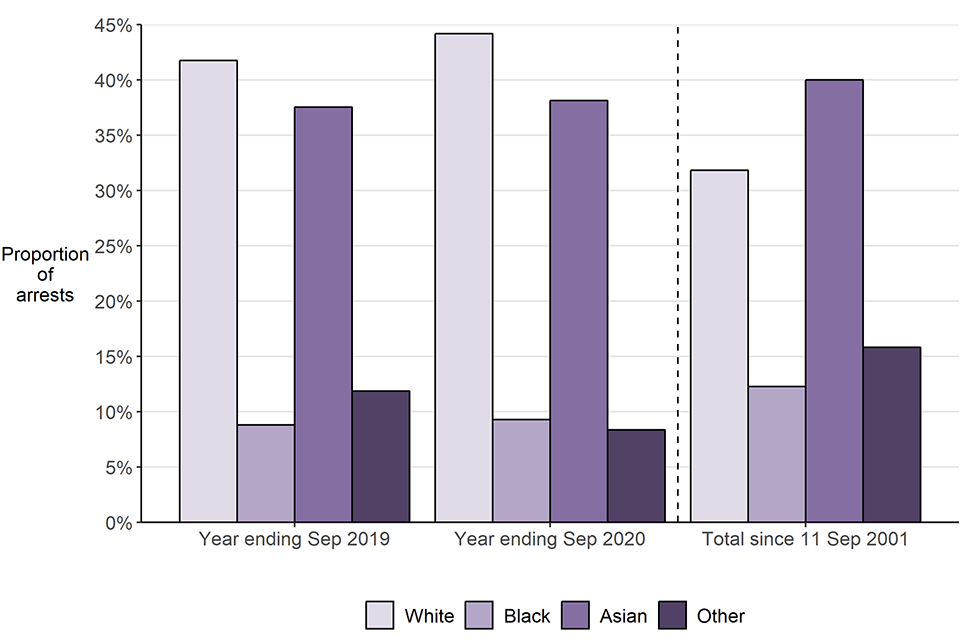
Source: NCTPOC (see data table A.11)
Notes:
- As recorded by the police at time of arrest.
- Excludes those whose ethnicity is not known.
Proportion of persons arrested for terrorist-related activity by ethnic appearance, year ending 30 September 2019 and 30 September 2020, compared with total proportions since 11 September 2001. In the year ending September 2020, arrests of persons of White ethnic appearance accounted for 44% of arrests, up 2 percentage points on the previous year. Those of Asian ethnic appearance accounted for 38% of terrorist-related arrests, and those of Black ethnic appearance was 9%, the same proportions as in the previous year. The proportion of those arrested who were of ‘Other’ ethnic appearance was 8%, down 4 percentage points on the previous year.
Nationality
Of those arrested in the latest year, 79% considered themselves to be of British or British dual nationality, up ten percentage points on the previous year and the highest proportion since the year ending September 2015. The proportion increased from 33% in the year ending September 2002, up to 77% in the year ending September 2012, and has not gone below 66% since then. Overall, since 11 September 2001 (when the data collection began), 62% of those arrested considered themselves to be of British or British dual nationality (Table 2.1).
Table 2.1: Number of persons arrested for terrorist-related activity, since 11 September 2001, by self-defined nationality1,2
Numbers & percentages, Great Britain
| Self-defined nationality | Total since Sep 11 2001 | Proportion of all arrests (%) |
|---|---|---|
| Great Britain3 | 2,953 | 62 |
| Algeria | 194 | 4 |
| Iraq | 173 | 4 |
| Pakistan | 170 | 4 |
| Iran | 92 | 2 |
| Afghanistan | 92 | 2 |
| Somalia | 83 | 2 |
| Turkey | 81 | 2 |
| India | 61 | 1 |
| Sri Lanka | 58 | 1 |
Source: NCTPOC (see data table A.11)
Notes:
- The nationalities presented here are those declared by persons at the time of arrest and may differ from their country of origin.
- Only the first 10 countries, by number of persons arrested for terrorist-related activity, are included in the table.
- Figures for Great Britain include those with ‘British dual’ nationality.
3. Court proceedings
Key results
- in the year ending 30 September 2020, 54 persons were tried for terrorism-related offences, a similar level to the previous year (53)
- of the 54 persons tried for terrorism-related offences, 49 were convicted (91%)
- of the 49 persons convicted of terrorism-related offences, 28 (57%) pleaded guilty and 21 (43%) entered a not-guilty plea
This section presents statistics on prosecutions for terrorism-related offences in England and Wales. It provides data on the number of persons prosecuted and convicted, including information on the legislation under which they were prosecuted. It also provides information on the length and type of sentence that each convicted person received. Data in this section are based on the trial completion date and are not directly comparable to the prosecutions data in section 2, Arrests and outcomes, which is based on the date of arrest.
Data are provided to the Home Office by the Crown Prosecution Service Counter Terrorism Division (CPS CTD). The data cover terrorism-related court cases that were completed in the 11 years from the year ending September 2010 up to the year ending September 2020.
3.1 Court proceedings
In the year ending 30 September 2020, 54 persons were tried for terrorism-related offences, a similar level compared with the previous year (53), but a fall of 37 (41%) from the peak of 91 trials in the year ending September 2018 (data table C.01). This peak in court proceedings in the year ending September 2018 followed from the peak in terrorism-related arrests in the previous year (as discussed in chapter 2).
During 2020, there has been an increase in the overall backlog of court cases, due to COVID-19[footnote 2]. However, the number of persons proceeded against by the Crown Prosecution Service for terrorism-related offences has remained fairly consistent during this period, reflecting that these more serious offences have been prioritised.
Of the 54 persons tried for terrorism-related offences, 49 were convicted. Figure 3.1 shows the outcomes for the 54 persons proceeded against.
Figure 3.1: Outcome of terrorism-related trials under TACT and non-TACT legislation, year ending 30 September 2020, England and Wales1
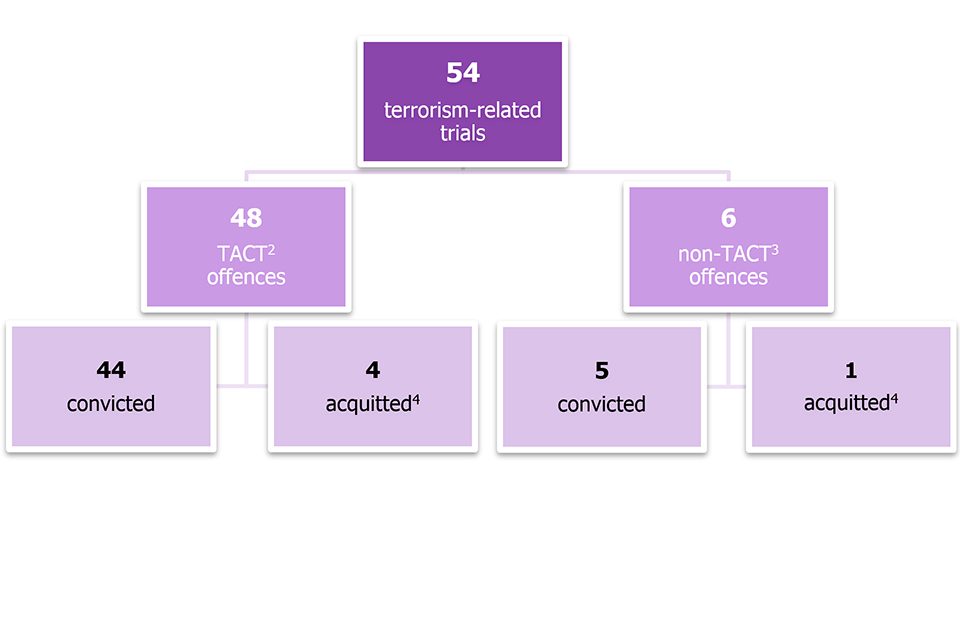
Source: CPS CTD (see data tables C.01-C.03)
Notes:
- Based on the principal offence for which the defendant was prosecuted against.
- TACT offences include offences specifically under terrorism legislation.
- Non-TACT offences include offences under other legislation.
- Can include trials ending in a hung jury, or where the prosecution offered no evidence.
Flow chart showing outcome of terrorism-related trials. In the year ending 30 September 2020, 54 persons were tried for terrorism-related offences, 48 for TACT offences, and 6 for non-TACT offences. Of the 48 persons tried for TACT offences, 44 were convicted and 4 were acquitted. Of the 6 persons tried for non-TACT offences, 5 were convicted and 1 was acquitted.
3.2 Sentencing
The most common sentence length in the latest year was under 4 years, which accounted for 47% of sentences (23 of 49 convictions). There were 11 sentence lengths between 4 and 10 years, accounting for 22% of the total.
Those given a life sentence accounted for 10% of all those sentenced in the latest year (5 sentences), up from 2% in the previous year (1 sentence). There were 2 sentences of 10 years or more, a decrease of 3 compared with the previous year. The number of non-custodial sentences increased from 1 to 7 in the latest year. There was also 1 hospital order in the latest year, the same as the previous year.
Of the 49 persons convicted of terrorism-related offences, 28 (57%) pleaded guilty and 21 (43%) entered a not-guilty plea. The proportion convicted that pleaded guilty was 14 percentage points lower the previous year, when 32 of the 45 persons convicted (71%) entered a guilty plea.
Figure 3.2: Sentence length for persons convicted for terrorism-related offences, year ending 30 September 2020 compared with the previous year, England and Wales1,2
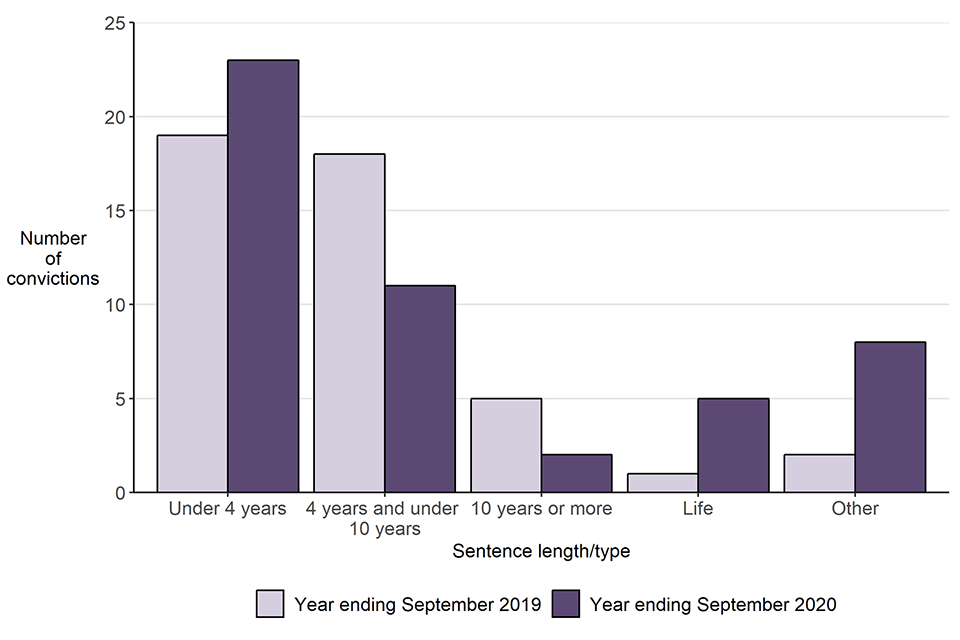
Source: CPS CTD (see data table C.04)
Notes:
- Based on the trial completion date.
- The ‘Other’ category includes hospital orders and non-custodial sentence
Graph showing sentence length by number of convictions, for year ending September 2020 and year ending September 2019.
4. Terrorist prisoners
Key results
- a total of 42 prisoners held for terrorism-related offences were released from custody in Great Britain in the latest year for which figures are available (year ending30 June 2020), down 13 compared with the previous year
Following changes agreed with the prison service, we are moving towards the adoption of the definition ‘Terrorism-connected offender’ to replace the previously used definition ‘Terrorism-related offender’ for prisoner statistics in this publication. A ‘terrorism-connection’ is a determination made by the sentencing court in accordance with Part 3 of the Counter-Terrorism Act 2008 and only after consideration of the requirements/matters specified in that Act.
Consistent information is not yet available on the new basis and for this reason, figures on the ideology, ethnicity, nationality and religion of persons in custody in Great Britain as at 30 September 2020 have not been included in this publication. We are working with data suppliers to ensure we can resume publication of these figures, on a new basis, in time for the next edition of this publication.
Data were provided to the Home Office by HMPPS and the Scottish Prison Service (SPS). Data on the number of prisoners released cover the 7 years ending 30 June, from 2014 to 2020, as well as the 9 quarters to 30 June 2020. Prisoner release figures as at 30 September 2020 are not yet available as these will form a subset of the prison releases statistics which will be published by the Ministry of Justice in their Offender management statistics quarterly release in January 2021.
4.1 Persons released from custody
A total of 42 prisoners held for terrorism-related offences were released from custody in Great Britain in the latest year for which figures are available (year ending 30 June 2020)[footnote 3], compared with 55 in the previous year. Of the 42 prisoners released, 34 (81%) were persons released from custody after serving sentences, many of whom will be subject to meeting certain licence conditions.
Of the 42 released from custody, 16 had received sentences of less than 4 years, and 18 had sentences of 4 years or more (including one life sentence). No one was released following an indeterminate sentence for public protection. Eight people had been convicted but not yet been sentenced.
For more details on releases from custody, see the user guide.
5. Other police powers under the Terrorism Act 2000
Key results
- in the year ending 30 September 2020, 502 persons were stopped and searched by the Metropolitan Police Service under s.43 of TACT 2000; this was a decrease of 25% when compared with the previous year’s total of 673
- in the latest year, there were 44 arrests resulting from a s.43 stop and search, down 38% on the previous year’s total of 71
- in the latest year, 4,486 persons were subject to the use of Schedule 7 to TACT 2000 in Great Britain; this was a fall of 57% compared with the previous year (when there were 10,347 examinations)
This section presents statistics on the use of stop and search powers available to the police under the Terrorism Act 2000 (TACT 2000). It includes data on the number of stop and searches, and resultant arrests, carried out under s.43 of TACT 2000 (by the Metropolitan Police Service (MPS) only) and s.47A of TACT 2000 (by all police forces). It also contains data on the use of powers under Schedule 7 to TACT 2000 in Great Britain. This includes the number of examinations, resultant detentions, strip-searches, the number of times postponement of questioning (usually to enable an individual to consult a solicitor) was refused, and the number of sea and air freight examinations.
Data on s.47a stop and search are provided to the Home Office by police forces, and data on s.43 stop and search are currently provided on a quarterly basis for this release by MPS only. S.43 stop and search figures for other forces are published annually by the Home Office in the Police powers and procedures release. Data on Schedule 7 are provided to the Home Office by the National Counter Terrorism Policing Headquarters (NCTPHQ). This section includes annual breakdowns for the last 9 years (when the data collection began) up to the year ending September 2020.
Following the Parsons Green attack, on 15 September 2017, the police used the power of stop and search under s.47a of TACT 2000 (previously s.44) for the first time. This power allows the police to exercise stop and searches when there is reasonable suspicion an act of terrorism will take place, and only when such powers are considered necessary to prevent such an act taking place. This was the first time they had been used in Great Britain since the legislation was formally amended in 2011. Following the attack on Parsons Green, 4 forces authorised the use of these powers: British Transport Police, City of London Police, North Yorkshire Police and West Yorkshire Police. There was a total of 128 stops (126 of which were conducted by BTP) resulting in 4 arrests (all BTP).
Further details on the use of s.47a can be found in the code of practice for the exercise of stop and search powers.
5.1 Stop and search under Section 43 of the Terrorism Act 2000
Section 43 of TACT 2000 allows a constable to stop and search a person whom he/she reasonably suspects to be involved in terrorist activity. This section includes data from MPS only and excludes ‘vehicle only’ stops and searches.
There was a large reduction in the use of s.43 stops between 2011 (when the data collection began) and 2014, during which time numbers fell 70%, down from 1,210 to 360 stops. There was then an increase in the next three years, up to a total of 735 stops in 2017. In the year ending 30 September 2020, 502 persons were stopped and searched by MPS under s.43 of TACT 2000, a decrease of 25% when compared with 673 in the year ending 30 September 2019.
In the latest year, there were 44 arrests resulting from a s.43 stop and search, down 27 (38%) on the previous year’s total of 71. 9% of stops resulted in arrest, down from 11% in the previous year.
Ethnicity was only stated in 68% of stops in the latest year, the lowest proportion since data collection began in 2011. The number of cases where ethnicity was known had previously steadily declined from 92% in 2011 to 80% in 2019. This information relies on the person stopped being willing to define their ethnicity.
In cases where the ethnicity was known:
- 36% identified as ‘White or White British’
- 32% identified as ‘Asian or Asian British’
- 16% identified as ‘Black or Black British’
- 12% identified as ‘Chinese or Other’
- 5% identified as ‘Mixed’
These proportions are very similar to the average proportion for each ethnicity seen over the last 5 years.
Figure 5.1: Stop and searches under s.43 of TACT 2000, MPS

Source: MPS (see data table S.01)
Notes:
- Excludes ‘vehicle only’ searches.
The graph shows number of stop and searches under section 43, by year, and whether the search resulted in arrest. There was initially a large decline in use of stop and search from 2011 to 2014. Number of searches then rose again until 2017. Since 2017 the number of searches have fallen again.
Figure 5.2: Arrest rate following top and searches under s.43 of TACT 2000, MPS

Source: MPS (see data table S.01)
Notes:
- Excludes ‘vehicle only’ searches.
The graph shows arrest rate by year. Arrest rate rose from less than 3% in 2011 to 10% in 2016. In 2020, 9% of stops resulted in arrest.
Details on the overall use of stop and search in England and Wales can be found in the Home Office Police powers and procedures, England and Wales statistical release. MPS also publishes monthly reports on the use of stop and search within its force area.
5.2 Schedule 7 to TACT 2000
Under Schedule 7 to TACT 2000, an examining office has a number of powers, the uses of which are covered in this section. These include:
- examinations of persons and resultant detentions
- strip-searches
- refusals to postpone questioning (usually to enable an individual to consult a solicitor)
- examinations of goods.
Data have also been provided on how frequently other powers have been used in Great Britain under Schedule 7 to restrict or qualify a person’s access to a solicitor. As well as ‘refusal to postpone questioning’, which has been published since 2016, this release now also covers use of powers where a person is:
- required to consult a solicitor by phone
- delayed access to a solicitor
- or required to consult in sight and hearing of a qualified officer.
Examinations and resultant detentions
An examining officer may stop and question individuals entering and leaving the country through ports, airports, international rail stations and the border area. When necessary they may also detain and search individuals. The aim is to determine whether or not that person is or has been concerned with the commission, preparation or instigation of acts of terrorism.
In the year ending 30 September 2020, a total of 4,486 persons were subject to the use of this power in Great Britain. This was a fall of 57% compared with the previous year (when there were 10,347 examinations), and 93% since the data were first collected in the year ending 31 September 2012 (when 61,711 persons were examined under Schedule 7). Prior to the most recent year there had been average annual falls of 22%.
There has been increased public scrutiny of this power in recent years, which may have driven a more targeted approach in its use. This is reflected in the increased rate of detention (see Figure 5.3).
There has also been a large reduction in examinations under Schedule 7 of TACT 2000 due to the lockdown measures imposed during the COVID-19 outbreak. Passenger numbers at air and sea ports in particular saw unprecedented low levels, with only 281 examinations between April and June 2020, compared with 2,527 between April and June 2019. The number of examinations increased to 836 in the quarter from July to September 2020, however this is only a third of the number of examinations carried out in the same quarter of the previous year.
Ethnicity was stated in 82% of cases, the lowest proportion since data collection began in 2011. Where ethnicity was known:
- 32% identified as ‘Chinese or other’
- 31% identified as ‘Asian or Asian British’
- 24% identified as ‘White’
- 8% identified as ‘Black or Black British’
- 5% identified as ‘Mixed’.
Since 2013 the proportion of White people examined has decreased steadily from 44% to 24%. In the same period the proportion of people who identified as ‘Chinese or Other’ increased from 19% to 32%. However, the proportion of White people detained has increased from 12% in 2013 to 17% in 2020.
The number of detentions following examination decreased by 25% from 1,972 in the previous year to 1,486 in the latest. Prior to this year the number of detentions following examination had increased for 2 years in a row, despite the decreasing number of examinations over that period. The Anti-Social Behaviour, Crime and Policing Act 2014, which came into effect in October 2014, amended the powers under Schedule 7 to TACT 2000 to ensure that a mandatory detention takes place where an examination lasts for longer than 1 hour. The rate of detention following an examination in the latest year was 33%, up from 19% in the previous year. This continues the upward trend in the rate of detention following examinations in recent years.
Figure 5.3: Number of Schedule 7 to TACT 2000 examinations1 and resultant detentions, 9 quarters to 30 September 2020, Great Britain
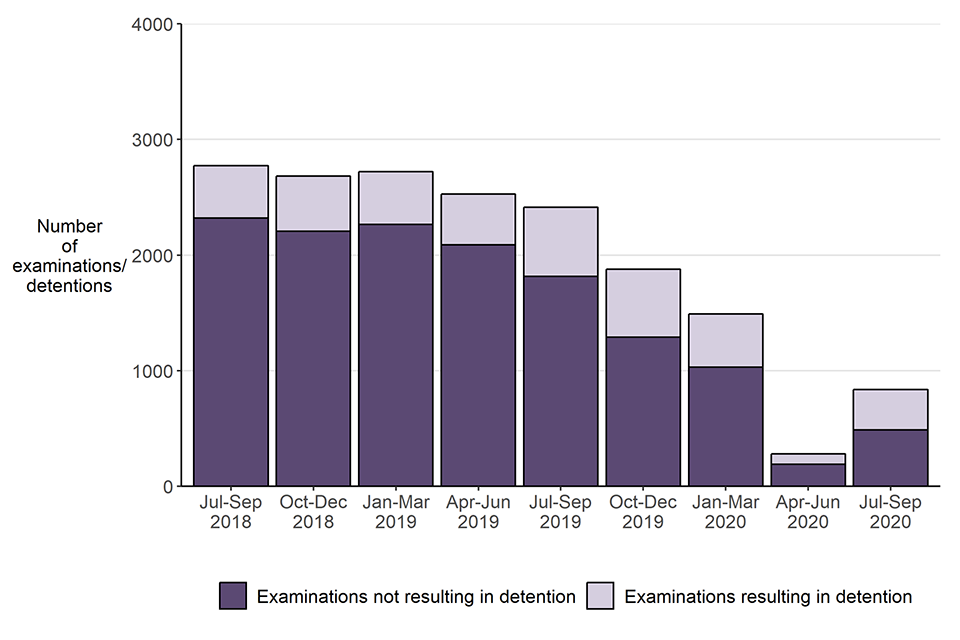
Source: NCTPHQ (see data table S.04)
Notes:
- Excludes examinations of unaccompanied freight.
Graph showing number of Schedule 7 to TACT 2000 examinations and resultant detentions, for the 9 quarters to 30 September 2020. There were only 281 examinations between April and June 2020, compared with 2,527 between April and June 2019. The number of examinations increased to 836 in the quarter from July to September 2020, however this is still only a third of the number of examinations carried out in the same quarter of the previous year.
5.3 Other powers under Schedule 7 to TACT 2000
The following section includes information on several additional powers under Schedule 7 to TACT 2000. This includes:
- strip-searches
- postponement of questioning refusals
- examinations of goods (sea and air freight).
Data on these powers have been collected by the Home Office since April 2015.
In the year ending 30 September 2020:
- 1 strip-search was carried out under the power
- a total of 518 air freight and 2,806 sea freight examinations were conducted in Great Britain; a decrease on the previous year of 56% and 35% respectively, and continuing the downward trend in use of this power since 2017
- postponement of questioning (usually to enable an individual to consult a solicitor) was refused on two occasions.
Furthermore, data have been provided on how frequently powers have been used to restrict or qualify a person’s access to a solicitor by: requiring the person to consult a solicitor by phone, delaying access to a solicitor, and requiring the person to consult in sight and hearing of a qualified officer. These data have been collected since April 2019.
In the year ending 30 September 2020, powers to restrict or qualify a person’s access to a solicitor were used twice. On these occasions the person was required to consult a solicitor by phone.
Details on each power can be found in the user guide.
6. Further information
Accompanying user guide and tables
The user guide provides further details on this release, including the strengths and limitations of the datasets, and the quality assurance processes involved in the production of this release. It also includes a summary of the criminal justice process, a glossary of terms used, and detail about the legislation and categories mentioned in this release.
A flow chart summarising the Arrests and outcomes section of this release can be found in Annex A.
Future Releases
The information published in the quarterly ‘Operation of police powers under the Terrorism Act 2000’ statistics is kept under review, taking into account the needs of users, and burdens on suppliers and producers, in line with the Code of Practice for Statistics. If you have any comments, suggestions or enquiries, please contact the team via email using: crimeandpolicestats@homeoffice.gov.uk.
Other related publications
The annual ‘Police powers and procedures’ publication provides information on use of various powers by police in England and Wales including: arrests for notifiable offences, stop and searches under section 1 PACE and associated legislation, Best Use of Stop and Search (BUSS) statistics, motoring offences, and detentions under the Mental Health Act 1983.
The annual ‘Individuals referred to and supported through the Prevent programme’ publication contains Experimental Statistics on the number of individuals recorded as having been referred to and supported through the Prevent programme due to concerns they were vulnerable to a risk of radicalisation.
Northern Ireland Security Statistics are published by the Northern Ireland Office at Northern Ireland Terrorism Legislation - Annual Statistics 2017/18.
Feedback and enquiries
We welcome feedback on the quarterly statistics release. If you have any feedback or enquiries about this publication, please contact crimeandpolicestats@homeoffice.gov.uk.
-
Demands on the police forces in England and Wales during the Covid-19 pandemic - National Police Chiefs’ Council – November 2020. ↩
-
CPS response to COVID-19: 16 March to 8 May 2020 – HM Crown Prosecution Service Inspectorate – June 2020. ↩
-
Figures as at 30 September 2020 are not yet available from HMPPS as these will be published by MoJ in October 2020. ↩
